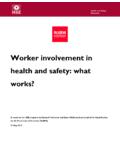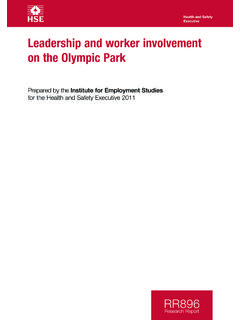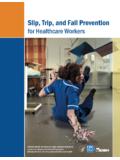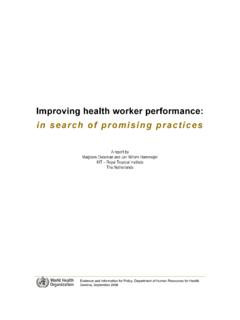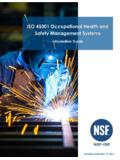Transcription of Warning! - UAW - Local 974
1 System Approach Conveyor Hoist, lift assist Lift table Reduce weight and size Lift truck Behavior safety Lift with your legs Lifting training Find safer workers Bingo contest Back belt safety Procedure Weight loss program Stretching exercises UAW, health and safety Department Publication #14 A Union Critique of Behavior-Based safety Warning! Behavior-Based safety Can Be Hazardous To Your health and safety Program! Jim Howe, CSP Assistant Director, UAW health and safety Department 8000 East Jefferson Avenue Detroit, Michigan 48214 Email Version 3, November, 2001 Copyright 1998, 1999, 2000, 2001 UAW, International Union 3 Introduction This paper is a critique of behavior-based safety programs. Such programs were born from seriously flawed research conducted in the 1930s and 1940s. These programs blame work-ers (the victims of occupational health and safety exposures to hazards) by focusing on worker behavior rather than problems of the system, such as hazards inherent to the work process.
2 By focusing on workers unsafe acts as the causes of injuries and illnesses, companies do little to address the root causes of safety and health risks. This document will: behavior-based safety ; where it came from; why behavior-based safety programs are popular; the real causes of occupational injuries and illnesses; the most effective methods of controlling hazards; where hazards come from; examples of effective hazard control; professional health and safety approaches and behavior-based safety ; the strengths and limitations of worker involvement and participation; whether behavior-based safety is consistent with modern approaches to quality and Dr. Deming s teachings; countermeasures to address human mistakes and errors; the problems with incentive programs, which are often implemented as part of a behavior-based safety program; and how behavior-based safety programs are "de-skilling" the health and safety profession.
3 What Is Behavior Based safety ? Behavior-based safety programs include a broad array of programs that focus almost en-tirely on modifying the behavior of workers in order to prevent occupational injuries and ill-nesses. The fundamental premise of these programs is that the overwhelming majority of injuries and illnesses are the result of unsafe acts. The first step in a behavior-based program is usually listing critical worker behaviors. Next, inspectors (observers) are selected to periodically monitor the work activities of work-ers. Most of the programs recommend that hourly workers be selected as inspectors. Each inspection is followed by positive or negative reinforcement. Origin of Behavior-Based safety Behavior-based safety is not new. In fact, it is one of the oldest and most outdated ap-proaches to health and safety . Behavior-based safety has its origin in work by H.
4 W. Heinrich (Assistant Superintendent, Engineering and Inspection Division of Travelers Insur-ance Company) in the 1930s and 1940s. Heinrich reviewed 12,000 insurance company ac-cident claims and 63,000 injury and illness records submitted by plant owners. The cases had been classified as caused by either unsafe acts or unsafe conditions (physical or me-chanical). The plant owners had attributed 25% of the cases to unsafe conditions and 73% 4 to unsafe acts. Heinrich reclassified 15% of the 25% originally classified as unsafe condi-tions to unsafe acts man failures. By adding the 15% to the 73% that were initially re-corded as man failures, he concluded that 88% of all industrial accidents were caused pri-marily by unsafe acts of persons. During the same period of time the National safety Coun-cil published a study that indicated that 87% of industrial accidents were caused by unsafe acts and 78% by mechanical hazards.
5 (The National safety Council study allowed cases to be classified with multiple causes.) *BST used these statistics for many years. Tom Krause, CEO of BST, explained to me in a private conversation that he has directed his staff to remove all references to these statistics from all of the company s publications. The statistics were not included in Tom s most recent book. In spite of this change, BST implementations continue to focus primarily on the behavior of workers while ignoring hazards and the management system. The accident reports in Heinrich s research were primarily completed by supervisors. Su-pervisor accident reports have always tended to blame workers for injuries and illnesses and suggest low-level ineffective controls, such as, advising workers to be more careful next time, follow a safety procedure or use personal protective equipment. Supervisors complete accident reports this way because they don t have adequate time to investigate and they think this is the way higher management wants them filled out.
6 Supervisor accident reports at most companies would be the same, and the result would be equally mistaken. Most su-pervisors feel that they have little upper management support and that resources for im-proved safeguarding, ergonomics, or chemical control are not available. Despite this, the be-havior-based safety advocates have continued to report Heinrich s flawed research as fact. Next, Heinrich developed a model that included what he thought were five factors in the acci-dent sequence. This basic idea has been incorporated into most of the behavior-based safety programs. Conclusion Source Heinrich 88% of all industrial accidents caused primarily by unsafe acts Industrial Accident Prevention, A Sci-entific Approach, Heinrich, page 19, second edition, McGraw-Hill Book Company, Inc, 1941, New York and London DuPont 96% of injuries and illnesses are caused by unsafe acts, 4% other causes Results of ten year DuPont study, safety Training Observation Program, Du Pont, Wilmington, Deleware (1986) Behavioral Science Technology (BST) 80-95% of all accidents are caused by unsafe behavior * The Behavior-Based safety Process, Managing Involvement For An Injury-Free Culture, Thomas R, Krause, John H.
7 Hidley, Stanley J. Hodson, page 12, Van Nostrand Reinhold, 1990, New York Quality safety Edge 76% of all accidents caused by behavior, 20% by behavior and conditions, 4% caused by condi-tions only The Values-Based safety Process: An Overview, page 3, Terry E. McSween, , President and Grainne A Mathews, , Project Manager, Quality safety Edge, Copyright 1997 5 These factors in chronological order are as follows: 1)Ancestry and social environment 2)Fault of person 3)Unsafe act and/or mechanical or physical hazards 4)Accident 5)Injury Ancestry and Social Environ-ment Fault of Person Unsafe Act and/or Mechanical or Physical Hazard Accident Injury The five factors in the accident. The injury is caused by the action of the preceding factors. Accident Factors Explanation of Factors 1. Ancestry and social environment Reckless, stubbornness, avariciousness, and other unde-sirable traits of character may be passed along through in-heritance.
8 Environment may develop undesirable traits of character or may interfere with education. 2. Fault of person Inherited or acquired faults of person; such as recklessness, violent temper, nervousness, excitability, inconsiderateness, ignorance of safe practice, etc., constitute proximate rea-sons for committing unsafe acts or for the existence of me-chanical or physical hazards. 6 The first and second elements ancestry and social environment and fault of person, which again, were the result of Heinrich s research deserve further explanation. Heinrich said that, The accident is caused by the action of the preceding factors. In other words, ancestry and social environment are factors in every accident according to Heinrich s theory, which he called Scientific Management. This view of accident causation compels the conclusion that 95% of industrial accidents were the result of unsafe acts. Heinrich was talking primarily about the actions of workers.
9 Proponents of behavior based safety programs all claim that the overwhelming percentage of injuries and illnesses in the workplace are the result of unsafe acts by workers. Some behav-ior-based programs make token statements about the actions of management being included in unsafe acts but, every one of the programs focuses at least 90% percent of the activity on workers. Heinrich s domino theory implies that in most cases a single cause (unsafe act) produced the injury. This is seldom the case. Even minor injuries have multiple causal factors. In almost every case, you can find a system problem. Trickery is used by those that say that 90% of injuries are caused by unsafe acts. The trickery involves focusing attention on the last act of the worker (victim) rather than the multiple underlying causes that set stage for the incident to occur. Such statements do a disservice by directing attention away from root causes and de-signs that are error provocative.
10 Major Points To Remember safety is not new. It is one of the oldest and most outdated theories and approaches to safety . safety had its origin in the 1930s and 1940s in the work of Heinrich. blaming is at the heart of behavior-based safety programs. The original theory that 95% of accidents are the result of unsafe acts was developed based on seriously flawed research. The companies selling behavior- based programs, which continue to support this position, have a financial interest in promoting this folklore. the past 40 to 50 years, this approach to safety , focusing primarily on unsafe acts, has been used widely in the United States. It has been one of the major barriers to im-proved injury and illness prevention. One need only review the supervisor accident re-ports at most any workplace and notice the accident cause and the corrective measures suggested. Ninety-five percent contain behavior-based countermeasures such as: more procedures, training, be more careful next time, or, wear personal protective equipment.
